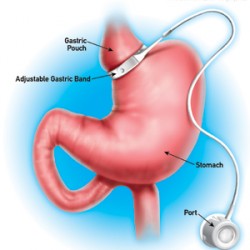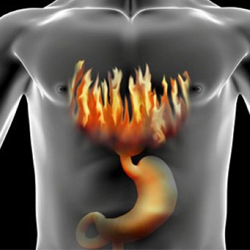
Gastric Band (LAPBAND)
The LapBand Operation
The LapBand, or laparoscopic gastric band surgery is currently the most common weight loss operation performed outside the United States.
The LapBand works by creating restriction of the amount of food that you can eat at a time. With small portions of food you will feel full for long periods of time. The inflatable balloon allows the surgeon to adjust the inside diameter of the LapBand to your needs so that you will lose weight by eating very little, not feeling hungry, and not having the urge to eat between meals.
With small portions of food you will feel full for long periods of time.
The LapBand or gastric banding procedure is usually recommended if you eat large amounts of food. In addition, it is at present the only bariatric operation performed in adolescents. It is not indicated if you have a large hiatal hernia, severe esophagitis, peptic ulcers, or some eating disorders.
| The advantages of the LapBand include: | |||||
|
|||||
|
|||||
|
|||||
|
|||||
|
|||||
|
|||||
|
|||||
|
|||||
The LapBand
The LapBand is the newest and the only adjustable surgical treatment for morbid obesity in the United States. It consists of a ring that is placed around the stomach in order to hold back the transit of food through the stomach, producing a feeling of fullness with small portions of food. The LapBand has an inner inflatable silicone balloon that can be adjusted depending on your needs. It does not contain latex or any natural rubber materials.
The LapBand is the newest and the only adjustable surgical treatment for morbid obesity in the United States.
Dr. Rodrigo Gonzalez uses the Lap-Band® System, which was approved by the FDA (Food and Drug Administration) in June 2001. It is currently the most common gastric band system used in the United States. For more information visit www.lapband.com
The LapBand technique
The LapBand operation is completed using the laparoscopic surgical technique. It requires general anesthesia and it takes about one hour to complete the entire procedure. All patients are given blood thinners and IV antibiotics before surgery. Additionally, you will have compressive stockings and an intermittent compressive device in your legs until you are completely recovered.
The technique for the LapBand placement involves four really small incisions and an additional incision of about one inch through which the gastric band is introduced and the port or reservoir is fixed to the abdominal wall muscle. The gastric band is placed around the most proximal portion of the stomach, in other words, close to where the esophagus ends and the stomach begins. It creates a shape in the stomach similar to that of an hourglass. It is fixed with sutures so it will not be displaced in the future. There is no cutting or stapling of the stomach. The reservoir is also fixed with sutures to the muscle, underneath the skin and fat tissue. No portion of the band is outside the skin.
The LapBand creates a shape in the stomach similar to that of an hourglass. There is no cutting or stapling of the stomach.
Recovery after LapBand surgery
The same day of your LapBand surgery you will be able to get out of bed and drink water in small amounts (one ounce every 15 minutes). Your IV fluids will be discontinued the night of your surgery and you will be discharged from the hospital the next morning. The average hospital stay is about 23 hours. You will be back to your routine physical activity on an average of 4 to 5 days following your surgery.
The average hospital stay following your LapBand surgery is about 23 hours. You will be back to your routine physical activity on an average of 4 to 5 days following your surgery.
La dieta después de la operación de banda gástrica
La dieta después de la operación de banda gástrica será avanzada de acuerdo a las recomendaciones de su nutricionista a una dieta de líquidos completos en la mañana siguiente de su cirugía. Una vez Ud. pueda tomar suficientes líquidos para evitar deshidratarse será dado de alta del hospital. Su dieta consistirá en líquidos y suplementos protéicos por una semana. Posteriormente, su dieta será avanzada a alimentos con consistencia de puré o papilla por dos semanas más. Ud. podrá comer alimentos de consistencia sólida tres semanas después de su operación de banda gástrica. No se necesitan suplementos nutricionales ni dietas especiales posteriormente.
Diet after LapBand surgery
Your diet will be advanced according to the recommendations of the dietitian to a full liquid diet on the morning following your surgery. Once you are able to drink sufficient amounts of liquids in order to avoid dehydration you will be discharged from the hospital. You will have a liquid diet including protein supplements for one week. Afterwards you will be advanced to a pureed-type diet for two weeks.
You will be able to eat solid food at three weeks after surgery. No additional nutritional supplements or special diets are required thereafter.
Fills or adjustments
During the operation, the LapBand is placed completely deflated. To modify the internal diameter of the LapBand, in other words tighten the band around the stomach, saline solution is introduced into the balloon. This is achieved by introducing a special needle through the skin into the reservoir. The first fill or adjustment is done about 4 to 6 weeks following surgery. Thereafter, the fills are scheduled according to your needs. They are indicated if you stop losing weight, if you start eating larger amounts of food, or if you feel hungry all the time. On average, patients require 3 to 4 fills per year.
Our experience
Dr. Rodrigo Gonzalez started his experience in gastric banding as a Fellow in Gastrointestinal Surgery at the University of Louis Pasteur in Strasbourg, France. He is certified both in the LapBand and Sweedish Adjustable Gastric Band (SAGB).
His training involved the evaluation and preparation of clinically significant obese patients for weight-loss surgery. He has performed hundreds of LapBand operations. He also received training in converting failed or complicated gastric bandings to Roux-en-Y gastric bypass.
Since his return to Guatemala, Dr. Rodrigo Gonzalez has dedicated most of his practice to bariatric surgery and has done well over hundreds of bariatric operations including Roux-en-Y gastric bypass, gastric banding, sleeve vertical gastrectomy, and revision of complicated or failed weight-loss operations to Roux-en-Y gastric bypass.
Dr. Rodrigo Gonzalez dedicated a significant amount of his time to study and research the field of Bariatrics. He has published over 25 papers in the most prestigious medical international journals and has been asked to write chapters for 5 books published in the United States and Great Britain. He has also been invited to publish review articles in renowned medical journals. He is considered by the international medical community as an expert in bariatric surgery and is therefore frequently asked to give talks in bariatric courses and meetings in order to present his experience in weight-loss surgery.




